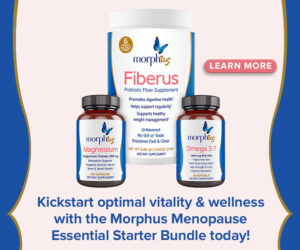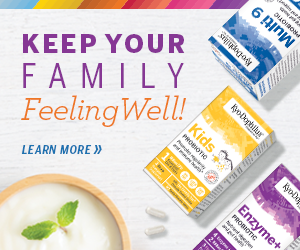
I hear it all the time: Canada is SO much stricter that the U.S. when it comes to labeling.
It may be true when it comes to supplements as they require a special license in order to be sold at retail. According to Health Canada, NPN's are product licenses that enable "any person or company that manufactures, packages, labels and/or imports Natural Health Products for commercial sale in Canada." Health Canada introduced this license in order to regulate the sales of supplements, and ensure Canadians are purchasing "safe, effective and high quality" products. Once Health Canada has deemed a product safe, it is assigned an NPN (Natural Product Number) which alerts consumers that it has passed Health Canada's scrutiny.
Read more about alternatives to processed foods
This isn't, however, the case for packaged foods.
My team and I researched countless products when writing all three of our books. We scrutinized labels from across North America and found that the U.S. and Canada have a lot of similarities when it comes to nutritional labeling, but they also have some major differences. For someone as obsessed with nutritional labeling as I am, understanding the nuances of each country’s labeling is SO important since I spend 99.9% my time on either side of the border.
Breaking Down Nutritional Labeling
GMO Labeling
Neither the U.S. nor Canada label GMO ingredients. In the U.S., Connecticut is the first state to pass a GMO labeling law, but there are in no uncertain terms, serious caveats. Four northeastern states need to pass labeling laws and one of them must border Connecticut for the law to take effect. The populations of the states must combine to at least 20 million people. Maine is the second state to pass a labeling law but the bill has the same caveats as Connecticut.
Currently, the only way to ensure that foods in both the U.S. and Canada are GMO-free is to buy certified organic products. According to the USDA, organic products are not allowed to contain GMOs-from the seeds, to the animal feed, to the end product.
Another way to avoid GMOs is to look for products certified with the NON GMO Project label. The NON GMO Project Verification program tests products for GMO content at points along the production chain considered to be high-risk for GMO contact. However it is important to note that this verification program is in line with the EU's stance on GMO labeling and allows for a product to be Non-GMO Verified if it contains 0.9% or less GMOs. I recently heard of another GMO verification label called GMO Guard. Feel free to check them out.
Trans-fats
Canada was the first country to mandate the disclosure of trans-fats on the Nutrition Facts Panel of packaged foods. Since December 2005, Canadian consumers could decide for themselves if they wanted to purchase products containing trans fats (this includes trans-fats from animals sources as well). By 2006, U.S. consumers could do the same, however it didn’t become mandatory for companies to disclose trans fats on the Nutrition Facts Panel until January 1st, 2008.
Unfortunately, even though we do our best to avoid trans fats by reading the Nutrition Facts Panel, we still manage to ingest them-but how?
A labeling loophole in the U.S. and less so in Canada allows companies to claim that their foods are trans-fat free when they’re not. In the U.S., food manufacturers are allowed to claim a product is trans-fat free if there is less than 0.5 grams per serving. Yes, I said per serving! As you can imagine, this adds up, as I demonstrate in my trans-fat video below.
In Canada, in order for a product to claim it’s trans-fat free, it must have no more than 0.2 grams of trans-fats per serving. Canada does a better job with trans-fat labeling, but ideally you want to avoid all trans-fats because even the smallest amounts per serving can add up to much more than you bargained for. 
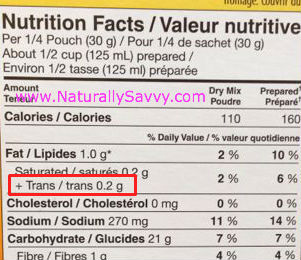
Many packaged goods companies are replacing trans fats with palm oil, and/or canola oil, which themselves, respectively, pose a potential environmental issue and is GMO.
In order to ensure packaged foods are trans-fat free, avoid the following specific ingredients:
• Partially hydrogenated oils
• Hydrogenated oils
• Shortening
• DATEM
• Mono and di-glycerides
We recently revised our Scary Seven list of ingredients to include mono and di-glycerides because they are fats that undergo partial hydrogenation, a process that produces trans fats. Because mono and di-glycerides are not “triglycerides” (The FDA only requires labeling trans fats if they are from triglycerides), food manufacturers can include them in their food products, but they don’t have to be labeled in the Nutrition Facts Panel as “trans-fats.” In addition, mono and di-glycerides, although they provide nine calories per gram, don’t have to be included in the Total Fat or Calories on a Nutrition Facts Panel.
Can anyone say, “loophole?”
Food Coloring
In the U.S., all food and drink labels must list the type of artificial colors they contain. To denote food-coloring agents, colors are assigned FD&C (Federal Food, Drug and Cosmetic) numbers, which are regulated by the FDA. This is important because individual food colorings can cause very different symptoms.
Artificial food coloring has a host of potential side effects including allergies, sinus congestion, hyperactivity, and worsened symptoms of ADD and ADHD. In our house, I can tell within 10 minutes if any of my kids ingest artificial colors because artificial food coloring makes my kids go crazy.
Here is a list of seven artificial food colors that the FDA approved for general use in food:
FD&C Blue No. 1: Brilliant Blue (blue shade), is inadequately tested and there has been suggestions of a small cancer risk.
FD&C Blue No. 2: Indigotine (dark blue shade).
FD&C Green No.3: Fast Green (bluish-green shade).
FD&C Red No.3: Erythrosine. High doses have been shown to cause cancer in lab animals.
FD&C Red No.40: Allura Red (red shade). Made mostly from petroleum, this dye can cause allergy-like reactions and has been linked to hyperactivity in children. It is also a potential carcinogen.
FD&C Yellow No.5: Tartrazine (yellow shade). Reactions can include rashes, skin allergies, asthma, or a runny nose. It is also linked to hyperactivity in children.
FD&C Yellow No.6: Sunset Yellow (orange shade). Linked to allergies, nasal congestion, nausea and hyperactivity in children.
Below is a package of M&Ms. You can see from its ingredients below how artificial colors are listed on a product found on the shelf of a U.S. store: 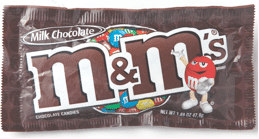

In Canada, food manufacturers are not required to list the type of food coloring used in their products. On a food label, you’ll see them simply listed as “colour”. Because each type of food coloring isn’t listed, it is best to avoid any product containing the word “colour” on a food label. Unfortunately “colour” is very easy to miss, especially when there is a long list of ingredients, so it is important to be extra diligent if you have small children and you are trying to eliminate artificial colors from their diets.
Here is an example of the SAME product shown above, Milk Chocolate M&Ms, but with Canadian ingredients:

So as you can see, if you live in Canada and never saw the U.S. M&M ingredient label, you wouldn't know it contained 10 different types of artificial colors in this one little package!
Keep that in mind next time you reach for an M&M.
High Fructose Corn Syrup
High-fructose corn syrup is at the top of our Scary Seven ingredient list. And with good reason as it can lead to obesity, insulin resistance, increased belly fat, and heart disease. High-fructose corn syrup can be found in everything from soda to peanut butter, juice, ketchup, and everything in between.
In the U.S. you will see it written on a food label as high-fructose corn syrup. 
In Canada, although it’s well labeled, you will see it written on a food label as “glucose-fructose.” 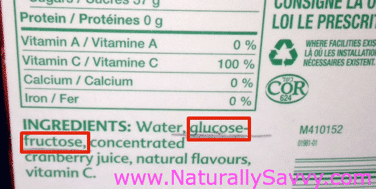
So while these two countries are neighbors and common allies in so many ways, with regards to food labeling, they don’t always agree on how to list them for the end consumer.
If you have any questions about U.S. versus Canadian food labeling, feel free to leave them in the comments below.


